Exploring the Science and Fun of Water Guns


Intro
Water guns, those brightly colored devices filled with liquid fun, have a rich history and an enchanting simplicity that belies the wonders lurking within their mechanics. From the basic squirt to complex pressure systems, water guns aren't just toys - they embody the principles of physics, encouraging both creative play and social interaction. This article dives deeply into the world of water guns, unraveling their evolution, examining how they work, and illustrating their impact on childhood enjoyment and education.
As we journey through the landscape of water guns, we will not only uncover interesting facts and trivia but also explore their scientific fundamentals. We invite curious young minds and their guardians to join us in this exploration of how these simple instruments contribute to learning and play. Let's get ready to unravel the mysteries and joys behind these awesome water shooters!
Science Fun Facts
When it comes to water guns, there are plenty of cool facts to quench your thirst for knowledge:
- The First Water Gun: The first water gun was patent in 1913 by a man named Frank D. Dorsey. It was called the "Water Pistol" and could hold a mere two ounces of water.
- Material Matters: Most modern water guns are made from various types of plastic, which help keep the gun lightweight while allowing for different styles and colors.
- Hydrodynamics in Play: Water guns use principles of hydrodynamics, which is the study of fluids in motion. The way the water flows out of the nozzle is a direct result of the pressure applied, demonstrating basic physics to kids.
"Water guns do not just provide amusement; they enable children to explore scientific concepts while having loads of fun!"
Interesting Trivia and Facts
- According to records, the largest water gun fight involved over 3,000 participants and took place in 2013 in Italy. This was a huge celebration of fun and community spirit.
- Did you know some water guns can shoot water up to 30 feet? Imagine the surprise on your friend's face when you soak them from a distance!
Quirky Science Stories
In the 1950s, a fun water gun craze swept through schools, and children would create contests to see who could shoot the farthest. This sparked debates among educators on whether such playful activities enhanced physical skills or led to mischievous behavior.
Discover the Wonders of Science
Water guns serve as delightful examples of how play can interlink with learning. Let us take a closer look at various scientific concepts showcased in the design and functionality of water guns.
Exploring Various Scientific Concepts
Understanding pressure and fluid dynamics can start from as simple a device as a water gun. When children squeeze the trigger, they are applying pressure which forces the water out through the nozzle. This interaction can lead to discussions about: Pressure
- Force
- Motion
- Volume
Educational Videos and Animations
For those eager to visualize these concepts, platforms like YouTube often host educational channels that explain the physics of water guns. Look for videos tailored for kids that explore science principles through engaging visual storytelling.
Interactive Learning Tools
Using water guns in experiments can make science tangible. For example, conducting a simple experiment to calculate different water trajectories encourages critical thinking and problem-solving.
Real-Life Applications of Science
Think about it: the principles can be applied in various professions from engineering to environmental science! Understanding how pressure works could even inspire young inventors to design their own water shooting gadgets!
Science Quiz Time
To reinforce what we’ve learned, here’s a little quiz to get those gears turning:
- What is the primary force that allows water to flow from a water gun?
- Who invented the first water gun?
- A. Gravity
- B. Pressure
- C. Magnetism
- A. Albert Einstein
- B. Frank D. Dorsey
- C. Thomas Edison
(Answers: 1 - B; 2 - B)
Brain Teasers and Puzzles
Using mathematical skills, try estimating how long it would take to fill a 1-liter bottle using a water gun set to shoot a steady stream of water. What if the stream shoots 2 liters per minute? How long would that take?
Science Experiment Showcase
Engaging children with science is enriching and fun! Here's a simple experiment involving water guns:
Fun and Engaging Experiments
- Do You Have Enough Power?
- Step 1: Gather three water guns, each of different types (pistol style, super soaker, and pump action).
- Step 2: Set up targets (like plastic cups) at various distances.
- Step 3: Time how long it takes each gun to hit the target.
Materials List
- Water guns (different types)
- Plastic cups
- Stopwatch
Safety Tips and Precautions
- Always ensure participants understand safety rules regarding play.
- Ensure the area is free of obstacles to avoid slips and falls while running.
As we continue to explore the fascinating intricacies of water guns, stay tuned for further sections that delve deeper into their way of creation, evolution, and multifunctional uses in both educational and recreational contexts!
The Evolution of Water Guns
The journey of water guns over the years reflects not just a transformation of a toy but a glimpse into cultural trends in recreational play. Understanding this evolution is essential as it illustrates how simple ideas can adapt to the needs and desires of different generations. Water guns have not only provided summer fun but have also woven themselves into broader societal contexts. Their development sheds light on advancements in technology, shifts in consumer preferences, and the growing appreciation for outdoor activities among children.
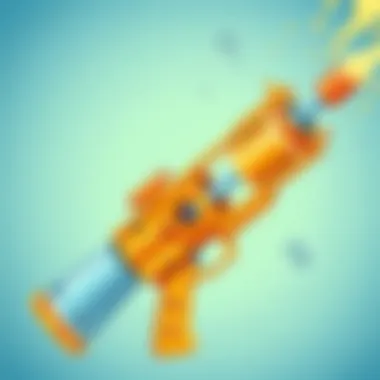
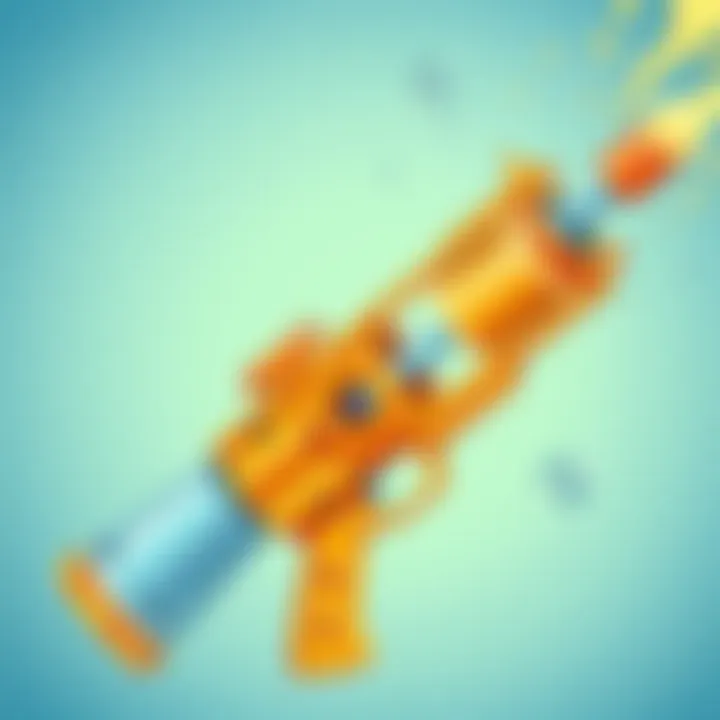
A Brief History
Water guns have a rather colorful history that starts way back in the mid-20th century. Originally, they were little more than a simple hand-pumped device. These early versions, such as the classic water squirters of the 1950s, were made from basic materials, often just plastic or rubber.
- Around the late ’70s, the idea took off with the introduction of the Super Soaker by Lonnie Johnson. This innovation changed the game immensely; it wasn’t just about getting a little wet — it was about power and performance. The Super Soaker revolutionized outdoor play, launching water fights into the stratosphere of excitement.
- Today, you can find water guns that reflect intricate designs and advanced functionality, from ergonomic grips to multi-nozzle features.
This evolution speaks volumes about how play has evolved alongside societal norms, emphasizing competitive outdoor fun over more traditional, less interactive forms of entertainment.
Technological Advancements
As water guns transitioned from simple designs to complex gadgets, various technological elements have enhanced their functionality. This also shows how innovation within the toy industry can have significant effects on how children play.
- Pressure Mechanics: Modern water guns utilize sophisticated pressure mechanics, allowing for longer ranges and more powerful streams. The incorporation of air pressure into water expulsion has led to designs that can shoot water several yards away.
- Material Improvements: The materials used in making these toys have also come a long way. Durable plastics and weather-resistant designs are now commonplace, enabling these toys to withstand rough use outdoors without breaking down too quickly.
- Design Features: Many models today have features like adjustable nozzles, varying spray patterns, and even built-in water tanks. Some models even sport LED lights, creating a more exciting play experience.
These advancements not only make water play more enjoyable but also encourage children to engage in imaginative scenarios, be it in a backyard showdown or during a playful battle at the beach.
In a world increasingly intertwined with technology, the evolution of water guns epitomizes how innovation can enhance play while promoting children's social skills and creativity.
Each of these changes not only enhances the appeal of water guns but also shapes the experiences of those who play with them. The combination of innovative design and engaging functionality keeps water guns at the forefront of children’s outdoor activities.
Types of Water Guns
When it comes to summer fun, water guns are among the most beloved toys in backyards and parks worldwide. Exploring the different types of water guns is essential to understanding their appeal and functionality. Each kind offers unique benefits, whether it’s the thrill of a classic squirt or the innovative designs that have emerged over the years. Understanding these varieties helps parents and kids alike choose the right toy for their next water battle or summer outing.
Classic Models
Classic water guns are often the first encounter children have with this type of toy. These models, usually made from lightweight plastic, come in simple designs with a trigger mechanism that draws water from a reservoir and squirts it out. The beauty of classic models lies in their simplicity and nostalgia. They are usually affordable, making them accessible for various age groups.
While many classic water guns shoot a decent stream, their range and power are generally limited when stacked against modern iterations. Yet, these toys often ignite creativity among kids. Here’s why they matter:
- Fosters Imagination: Kids can create elaborate scenarios and games around these simple devices.
- Family Bonding: Playing with classic models can unite families for some outdoor fun.
- Ease of Use: The straightforward mechanics make it easy for younger children to handle.
This blend of ease and classic appeal ensures that these models hold a special place in the hearts of many.
High-Pressure Variants
Transitioning from the simplicity of classic models, high-pressure water guns represent a significant departure in design and capability. These sophisticated devices utilize a pressure mechanism, increasing the shooting distance and power. They often consist of a larger tank and a pump system, turning a regular water squirt into an exhilarating spray.
High-pressure variants tend to offer:
- Extended Range: Capable of shooting water over long distances, giving players a tactical advantage in games.
- Variable Nozzles: Some models allow users to adjust the jet of water, making it not just a spray but a powerful stream for targeted fun.
- Durability: They are often constructed with sturdier materials to withstand intense play.
Children appreciate the excitement these models bring, as they can engage in dramatic backyard battles where strategies come into play. The rush of being soaked by a high-pressure blast adds an adrenaline element to standard water fights.
Water Blasters
Another exciting evolution in the water gun world is the water blaster. These guns often incorporate larger reservoirs, providing players with a more prolonged experience without the need for frequent refills. Water blasters are designed for serious water warfare, appealing especially to older kids and teens. Some notable characteristics include:
- Large Capacity: They hold more water, enabling longer play sessions.
- Ergonomic Designs: Many water blasters come with shoulder straps and grips that make carrying and maneuvering the gun easier.
- Multifunctional Options: Several models now include various features like automatic spraying or multiple firing modes.
Ultimately, water blasters combine both the aesthetics and functionality, catering to those who seek a more intense water combat experience.
"Understanding the types of water guns aids parents in picking the right fit for their child's play style."
Knowing the differences among these water guns can prove invaluable. Whether it’s for a calm day under the sun or a full-blown backyard skirmish, selecting the appropriate type transforms water play into cherished summer memories.
Mechanics of Water Guns
Understanding the mechanics of water guns is like peeling back the layers of an onion – the more you delve, the more you discover about the intricate design and functionality. This section shines a spotlight on how these delightful toys operate and why their mechanics are so crucial to the overall experience of play. Knowing how a water gun works, and the science behind it, can boost not only enjoyment but also enhance a child’s curiosity about physics in action.
How Do They Work?
At the heart of every water gun lies a remarkably simple yet effective mechanism. When you pull the trigger, a series of actions unfurl, sending water flying. First and foremost, let's talk about the pumping action: the user compresses a handle or trigger that forces the water out through a nozzle. This process leverages basic principles of physics, such as pressure and flow. The pathway water takes can vary between models, but the core idea remains the same.
To elaborate, here's a general rundown:
- Water Storage: Water is drawn from a reservoir, which is often a container or tank on the gun.
- Pressure Build-Up: The action of pulling the trigger or handle reduces the volume in the air chamber, effectively increasing pressure.
- Ejection: When released, the built-up pressure pushes the water through a nozzle, resulting in a jet stream.
This simple yet effective design captivates young minds and encourages them to wonder about what’s happening around them. They’re not just spraying water – they’re learning about basic physics!
The Role of Pressure
Pressure plays an indispensable role in water guns. Depending on how much force is applied to the trigger, the water can shoot out at various velocities. The greater the pressure, the farther and faster the water can travel.
Here are key points regarding pressure in water guns:
- Variable Stream Distance: Some water guns allow users to adjust the pressure settings, altering the stream of water from a gentle sprinkler to a high-impact jet.
- Impact Force: Higher pressure can create a more forceful impact, which can be exciting in playful water battles.
- Safety Considerations: While pressure is fun, manufacturers must ensure that their toys remain safe for all ages. Excessive pressure can lead to injuries, hence the design often includes limits to keep family fun intact.
"The simple act of pulling a trigger involves fascinating science – from pressure cuts to fluid dynamics, water guns embody real-world physics!"
As we see, the mechanics of water guns not only set them apart in the realm of toys but also serve as an engaging introduction to the concepts of science for children. Knowing the mechanics behind these devices can enrich playtime, transforming it into an opportunity for education and creativity.
By understanding how these mechanics make water guns work, children and caregivers alike can appreciate the nuances of play further, encouraging interactions that blend fun with learning.
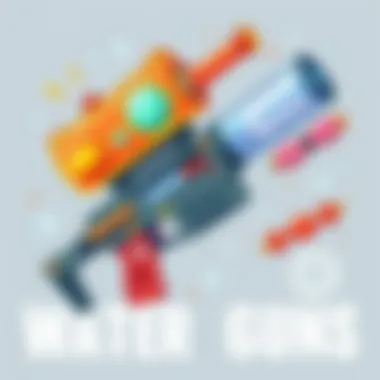
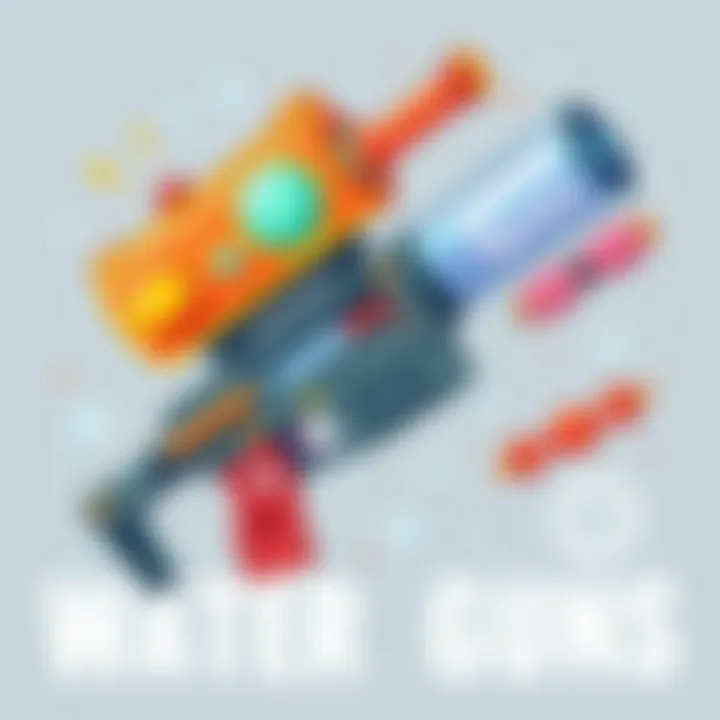
Designing an Awesome Water Gun
Design plays an essential role in the creation of water guns. It is not just about how they look, but about how they function effectively and safely. An awesome water gun needs to be eye-catching to grab attention, but it should also be practical for outdoor fun, especially during those hot summer days. In this section, we'll explore the materials used in crafting these toys and the ergonomic features that enhance the user experience.
Materials Used
When it comes to constructing water guns, the choice of materials can make a significant difference in performance and safety. Traditional water guns often used hard plastic, which is lightweight and affordable but may not always be the best choice when it comes to durability or environmental impact. Today, manufacturers are starting to explore other options:
- Plastic: The most commonly used, light and easy to mold into various shapes.
- BPA-Free Materials: Increasingly important, these ensure that the products are safe for children.
- Recycled Plastics: This sustainable option helps reduce waste while still producing high-quality toys.
- Natural Rubber and Silicone: Some newer models incorporate these materials, as they are both durable and eco-friendly.
Investing in water guns made from high-quality materials means better longevity during those enthusiastic play sessions, as well as fewer concerns for parents regarding safety and environmental friendliness.
Ergonomic Considerations
An often overlooked aspect of water gun design is how comfortable and intuitive they are to use. Good ergonomics ensures that children can handle these toys with ease during their water battles. Here are some essential ergonomic features to consider:
- Grip Design: Water guns should have handles that fit comfortably in small hands, making them easy to hold and maneuver.
- Weight Distribution: A well-balanced water gun allows for better control, avoiding fatigue as kids engage in prolonged play.
- Trigger Mechanism: The trigger should be responsive and easy to pull, preventing frustration when trying to shoot water quickly.
By considering these ergonomic factors, designers can create water guns that not only perform well but are also enjoyable and safe for children to use.
"A well-designed water gun not only enhances the fun but also ensures that kids keep coming back for more, fostering creativity and social interactions through play."
As we dive deeper into the world of water guns, it becomes clear that meticulous attention to designing these toys—through thoughtful material selection and ergonomic features—adds layers of enjoyment and safety for all participants. Manufacturers who stay attuned to the needs of their young users can create products that stand the test of time and trend, ensuring Water Wars remain a summer favorite.
Safety Features in Water Guns
The realm of water guns isn't all about fun in the sun. An essential aspect that deserves a spotlight is the safety features integrated into their design. Water play can be a delightful experience, but it holds its own set of risks, especially when young children are involved. A well-designed water gun can not only elevate the playful experience but also ensure that safety is at the forefront. In this section, we’ll dive into various elements that reflect the commitment to user safety in these playful devices.
Child Safety Standards
To ensure that our little ones engage safely while having a blast, water guns must comply with strict child safety standards. These standards are established by regulatory bodies that consider numerous factors:
- Materials Used: Toys, including water guns, should be made from non-toxic plastics. Children often put toys in their mouths, so ensuring that all components are safe is critical.
- No Small Parts: A water gun designed with large components caters to the age group it's meant for. Avoiding small parts helps eliminate choking hazards that could lead to unfortunate situations.
- Squeeze and Trigger Mechanisms: The design of the trigger mechanism should demand a safe grip, preventing any accidental discharge of water when it's not desired.
- Pressure Limits: Safety standards stipulate specific pressure limits for water guns. This ensures even the most enthusiastic squirt gun fights remain safe rather than becoming painful encounters.
It's crucial for manufacturers to abide by these regulations so that parents can have peace of mind when they hand a water gun to their child.
Safe Play Guidelines
Beyond the safety standards that govern the design and production of water guns, particular guidelines should be adopted for safe play. These guidelines not only protect children but also enhance their enjoyment of water play:
- Supervised Play: It's advised that children play with water guns under adult supervision, particularly younger kids. Close supervision can prevent mishaps and ensure safety during play.
- Setting Boundaries: Establishing clear play areas can help mitigate risks associated with slippery surfaces. A designated play zone keeps the fun focused while minimizing potential accidents.
- Hydration: Encourage kids to take breaks for water, especially on sunny days. Staying hydrated is always rule number one, even during water play.
- Respect for Others: Teaching children to respect others' boundaries can transform a simple water fight into a delightful experience filled with laughter and joy instead of unexpected surprises.
"The principle of safety is not just about preventing accidents. Rather, it's about creating an environment where joy can thrive harmoniously with caution."
By imparting these safe play guidelines, caregivers play a vital role in instilling a sense of responsibility in children. This cognitive understanding reaps benefits down the road, promoting safe decision-making in other areas, too.
The Role of Water Guns in Play
Water guns, beyond their amusing nature, play a crucial role in children's outdoor activities. They act as more than just toys; they are conduits for exercise, creativity, and meaningful social interactions. This section explores the multifaceted benefits of these playful water shooters and how they enrich our children's experiences.
Benefits of Outdoor Play
Engaging in outdoor play is paramount for the healthy development of children. Water guns facilitate this by providing a fun, interactive way to enjoy nature. When kids run around in open spaces, spraying water, they are not just having fun; they are also getting a workout. The physicality of aiming and dodging during a water fight helps build their strength and endurance. Additionally, it promotes:
- Motor Skills: Running and maneuvering with a water gun hones fine motor skills as children learn to aim and shoot.
- Coordination: The action of pumping and aiming requires hand-eye coordination, essential for various activities as they grow.
- Balance: Kids develop better balance as they dart around, move swiftly, and navigate different terrains while engaged in these playful bouts.
According to the American Academy of Pediatrics, outdoor play is vital for children’s physical and emotional health. Water play can be particularly stimulating, encouraging children to navigate different setups, whether it’s slipping on grass or splashing in a puddle.
Encouraging Social Interaction
Water guns also foster social connections. When kids splash one another in an organized water fight or an impromptu backyard showdown, they are engaging in cooperative play. This type of play is a cornerstone of childhood development. It nurtures bonds and teaches valuable lessons in teamwork and strategy. Some key points include:
- Communication Skills: Planning a water gun ambush or negotiating teams broadens their vocabulary and enhances their social skills. For instance, a child may suggest hiding behind a tree for a surprise attack.
- Conflict Resolution: Disagreements arise in games, and children learn to solve these problems on their own, which strengthens their ability to manage conflicts respectfully.
- Inclusivity: Water games often invite a diverse group of children, fostering an environment where everyone can participate, regardless of skill level.
"Playing with others, like in a water fight, promotes camaraderie and happiness among children, creating cherished memories that last a lifetime."
Water Guns as Educational Tools
Water guns might seem like mere toys, but they are increasingly recognized as tools for learning and development. They offer more than just splashes of fun; they provide unique opportunities for children to engage with fundamental principles in science while nurturing creativity and social skills. Using water guns as educational tools lays ground for experiential learning that enhances understanding in various subjects, particularly in physics, environmental science, and team dynamics.
Incorporating Science in Play
When children play with water guns, they are actively engaging with scientific concepts without even realizing it. For instance, when aiming a water gun, they learn about angles and trajectories—ideas that belong to basic physics.
- Hydrodynamics: As kids pull the trigger, they see firsthand how water pressure can propel liquid over distance, introducing them to fluid dynamics. It’s an enjoyable way to explore pressure and flow.
- Gravity Effects: When water arcs through the air, it demonstrates the principles of gravity at work. Kids learn that the water eventually falls back down, and they can experiment by changing the angle of their shots.
By turning playtime into informal science lessons, children are encouraged to be curious and ask questions. This organic inquiry fosters a scientific mindset that can benefit them throughout their educational journey.
Experiments with Water Guns
The playful nature of water guns lends itself to numerous practical experiments that harness children's curiosity. Here are a few engaging ways to conduct experiments with them:
- Distance Testing: Kids can fill their water guns with varying amounts of water and measure how far they can squirt it. This can lead to discussions about the impact of water volume on distance traveled.
- Temperature Experimentation: Fill water guns with water at different temperatures. Kids can observe how temperature influences the feel and performance of the water jet.
- Color Play: Using food coloring in the water can lead to explorations of color mixing and visual arts, providing a multi-sensory learning experience. At the same time, this combination serves as a lesson in safety practices, as participants learn to keep certain colors away from clothing.
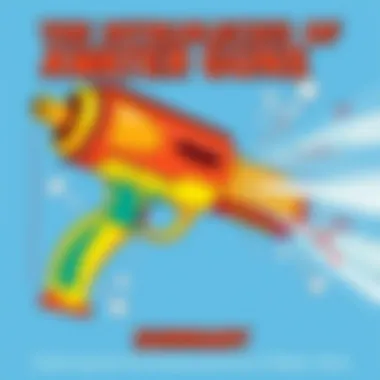
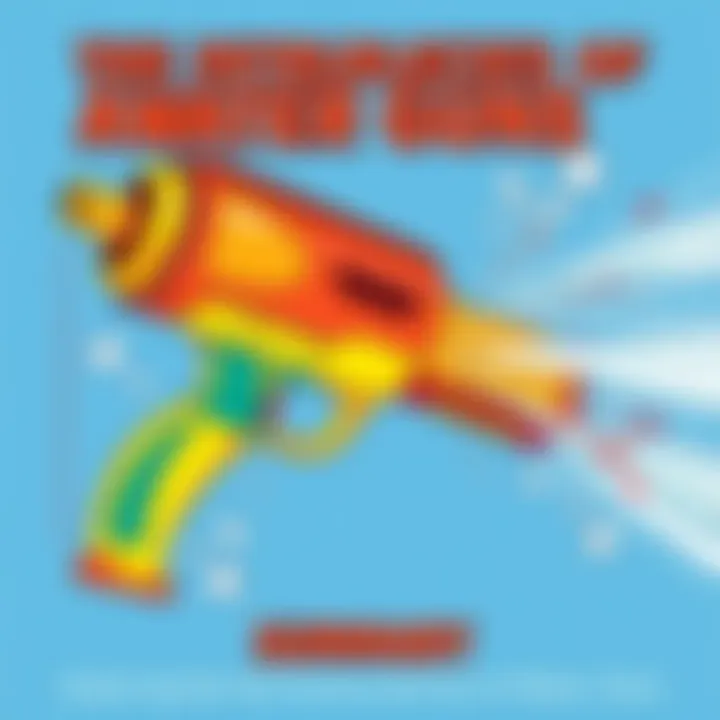
- Question: Does more water mean more distance?
- Question: Is cold water harder or easier to aim?
- Question: What happens when different colors mix in the air?
Engaging in these playful experiments encourages children to formulate hypotheses, conduct observations, and analyze results, which are critical components of the scientific method.
By utilizing water guns for science experiments, parents not only make learning fun but also emphasize play as an effective medium for educating young minds. This approach helps in building a strong foundation for problem-solving skills, creativity, and teamwork in a light-hearted setting.
Environmental Considerations
Exploring the environmental considerations related to water guns sheds light on how these seemingly simple toys can impact our planet. As we delve deeper into this topic, it becomes clear that understanding and practicing responsible usage can help mitigate potential environmental harm.
Water Conservation Practices
Water guns, while fun, often use large amounts of water. This raises the question of sustainability and conservation. Here are several ways to practice good water conservation when using water guns:
- Set Limits: Encourage kids to fill their water guns with just enough water for a good play session. It eliminates waste and teaches them to understand conservation.
- Share Water: Create games that involve sharing water among friends, encouraging teamwork and saving resources.
- Use Natural Water Sources: Whenever possible, utilize rainwater or outdoor bodies of water, promoting a connection to nature and reducing reliance on your home water supply.
Keeping these practices in mind helps instill a sense of responsibility among children, prompting them to consider how they can have fun while also respecting our planet's resources.
Eco-Friendly Materials
The materials from which water guns are made can significantly impact their environmental footprint. Ideally, an awesome water gun should be made from eco-friendly materials. Here's what to look for:
- BPA-Free Plastics: Many manufacturers are now producing plastic toys without BPA, a harmful chemical often found in traditional plastics. Opting for these products ensures safer play and less environmental impact.
- Recyclable Components: Choosing water guns that can be easily recycled goes a long way. When the fun is over, it's important that the toys don’t just end up in a landfill.
- Biodegradable Options: Some companies are experimenting with biodegradable materials for toy production. These options are still being developed but can reduce long-term waste dramatically.
Ultimately, selecting water guns made from sustainable materials contributes to a healthier environment. It helps teach kids about the importance of making environmentally conscious choices in their playtime activities, fostering a broader understanding of ecological responsibility.
"Teaching children about water conservation and eco-friendly materials instills lifelong habits that can have a lasting positive effect on our planet."
By embracing these environmentally considerate practices and materials, families can enjoy their outdoor water games without sacrificing the health of our Earth.
The Cultural Impact of Water Guns
Water guns have established a unique imprint in our culture, weaving their way into the fabric of childhood memories and community interactions. This section explores how these colorful toys transcend simple play and become a means for social bonds, collective creativity, and even global variations of leisure.
Water Gun Fights in Popular Culture
From backyard skirmishes to epic showdowns portrayed in movies, water gun fights have become iconic in popular culture. Think back on scenes from films like The Sandlot or animated shows that feature battles with water blasters; these images not only entertain but also resonate with the reality of youthful exuberance.
Movies, cartoons, and even viral videos have celebrated this form of play, transforming the act of a water fight into a relatable rite of passage. It's not just about getting wet; it symbolizes freedom and the joy of childhood, where the simplest things often bring the most thrill. An example that comes to mind is the annual water gun battle in cities like Las Vegas during the monsoon season, where spontaneous gatherings take place, demonstrating how natural it is for communities to come together for a good old-fashioned splash.
"Water gun fights are not just about water; they are about connection, laughter, and sometimes even rivalry."
Moreover, the depiction of water guns in various media often emphasizes inclusivity and friendship, encouraging teamwork and cooperation among participants. Such representations draw in kids from different backgrounds, reinforcing the idea that despite differences, everyone can engage in the joy of play.
Global Variations of Water Play
Water guns are not merely localized toys; they are embraced around the globe in myriad forms, each with unique cultural significance. For instance, in Thailand, the traditional Songkran festival involves water fights that symbolize the cleansing of sins and is celebrated with considerable zeal. People of all ages participate, using everything from large water guns to buckets, highlighting community togetherness.
In Japan, there are festivals where participants engage in water balloon throwing, known as suikawari, akin to a water-based version of a piñata. While not exactly the same as a water gun fight, it encapsulates the playful spirit that reigns in warmer months.
- Italy has its own charming take with water balloon games at their summer festivals, allowing participants to indulge in playful rivalry,
- The United States often sees summers marked by neighborhood water gun battles and organized tournaments.
The beauty of these variations lies in their ability to convey happiness across cultures. Regardless of geographic location or cultural context, water play invites joy and friendship. An interesting fact is that often, the intensity of the water fights diminishes with age; but they remain cherished memories for many.
These global encounters with water gameplay emphasize how apart from being a fun activity, they serve as an essential tool for social interaction, bridging gaps between generations and cultures, and fostering connection in a world that sometimes feels divided.
Through examining the cultural significance of water guns, it becomes clear that their impact goes beyond the realm of simple toys. They are vessels of joy, communal experiences, and lasting memories.
Future Innovations in Water Gun Technology
In an ever-evolving world where technology touches nearly every aspect of our lives, water guns are not left in the dust. The future of water gun technology holds promise not just in enhancing playtime fun, but also in fostering environmental responsibility and educational opportunities. The incorporation of innovative features could transform these toys into much more than simple recreational items.
Understanding these innovations is crucial, especially for parents and caregivers who hope to combine fun with safety and learning. The next wave of advancements assures a more interactive, informative, and eco-friendly experience when it comes to splashing fun.
Smart Water Guns
Imagine a water gun that not only squirts water but also connects to your smartphone. Smart water guns are on the horizon, equipped with sensors that can monitor water levels, temperature, and even the distance of the spray. These gadgets could offer features like an augmented reality game that interacts with the physical environment, teaching kids about physics as they shoot water at virtual targets.
Some potential features of smart water guns include:
- App Integration: Kids could track their water fights, compete in challenges, or learn about water pressure through interactive games.
- Adjustable Settings: Users might adjust the intensity and distance of water streams with a simple app, enhancing user experience based on age or skill level.
- Educational Tie-Ins: Each water fight could include learning objectives, turning simple play into meaningful learning experiences.
This technology not only emphasizes play but encourages kids to think critically and learn while they enjoy their favorite summer activity.
Sustainable Design Trends
As society increases its focus on sustainability, the design of water guns is also adapting. Future innovations are likely to incorporate eco-friendly materials and practices, reducing their environmental footprint. Sustainable water guns can be made from recyclable or biodegradable materials, helping to preserve the environment for future generations.
Considerations for sustainable water gun designs may include:
- Materials: Utilizing recycled plastics or plant-based materials can lead to a lesser impact on the planet.
- Water Efficiency: Innovations may focus on how much water is used in each gameplay, promoting conservation while ensuring the fun isn't compromised.
- Durable Designs: Crafting water guns that are built to last reduces waste from replacement products, encouraging long-term enjoyment rather than short-term use.
"Few things in life can bring as much joy as a good water fight, but it's vital we keep our playgrounds clean and green."
In essence, future innovations in the water gun industry appear not just exciting through added features, but also responsible, bringing forth an educational twist while considering environmental implications. This blend of functionality and ethics can ensure that today’s water-fueled fun does not come at the expense of tomorrow’s world.







